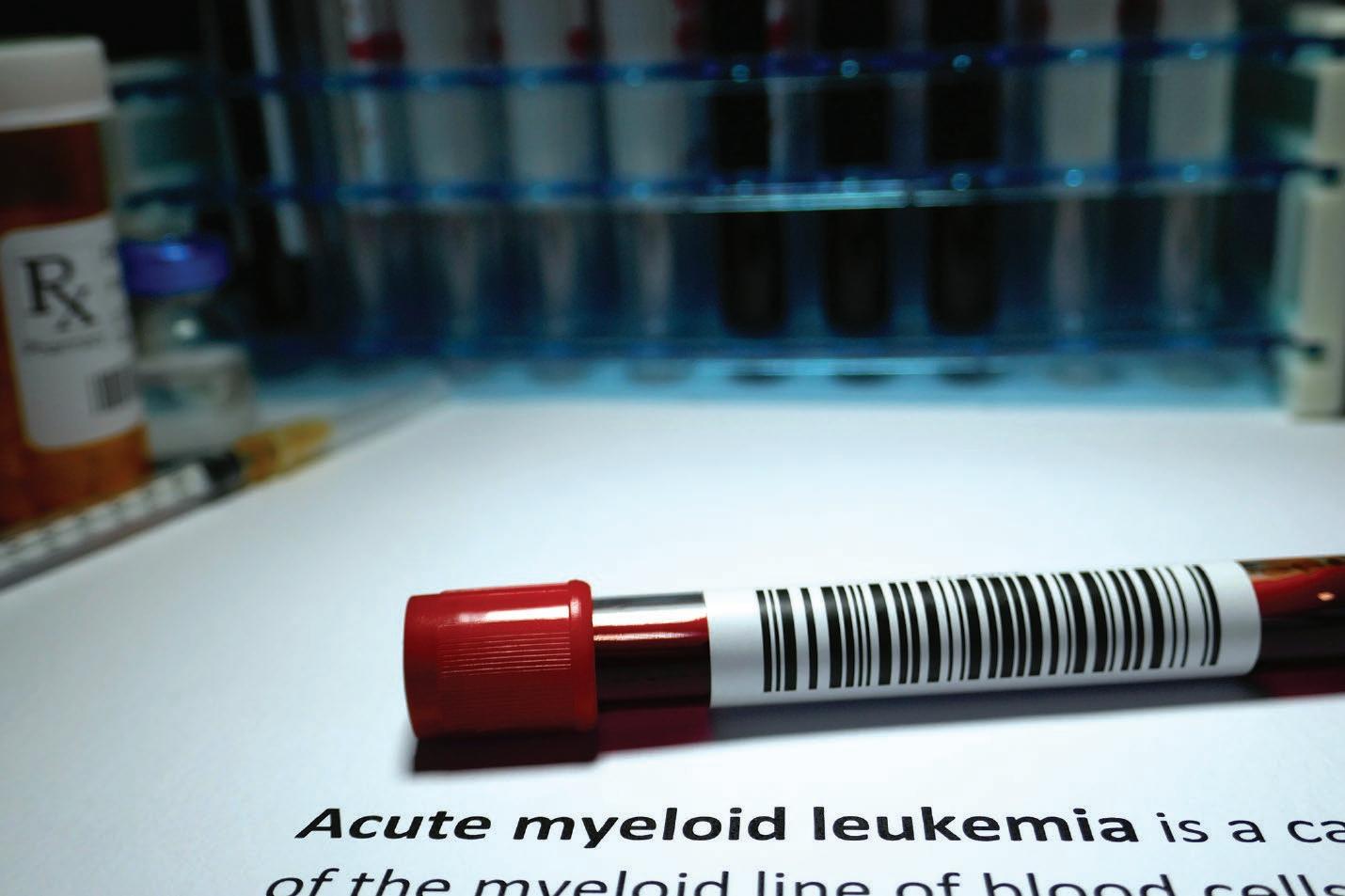
4 minute read
Urgent Need for More Targeted Agents for Relapsed and Refractory AMLPatients
Urgent Need for More Targeted Agents for Relapsed and Refractory AML Patients
Anna Love, M.B.S., Ph.D.
For AML, the terms refractory and relapse are nuanced and have specific markers. Most AML patients achieve disease remission after initial treatment. After receiving two full cycles of intensive induction chemotherapy, residual leukemic cells may remain in the marrow, and these patients are diagnosed with refractory AML. Patients with refractory AML may be candidates for stem cell transplants if they achieve remission. AML patients who reach remission and then have leukemia cells return are diagnosed with relapsed leukemia. 25
The treatment landscape for AML has not changed much over the last 30 to 40 years, with the majority of treatment decisions revolving around the intensity of chemotherapy and possible hematopoietic stem cell transplantation (HSCT). Outcomes of this standard of treatment are poor. Between 50-60% of AML patients over 60 years of age achieve complete remission with standard induction therapies, with only 10- 20% of patients surviving 4 years or more. 26 For AML patients with relapsed and/or refractory disease, treatment outcomes are downright dismal. Patients with relapsed/refractory disease have a cure rate of less than 10%, with stem cell transplants being possible for a minority of this subset.26 For older patients, the 10-year disease-free survival rate is approximately 2%. 27 Indeed, most patients with AML die from progressive disease after relapse. AML relapse is associated with new point mutations and clonal evolution at the cytogenic level, likely shaped by the chemotherapy received by the patients for initial treatment. 28 As it stands, the reliance on standard chemotherapy alone leaves a huge treatment gap in terms of potential initial treatments and possibly promoting disease relapse.
Identifying and understanding the molecular complexity and genetic mutations associated with AML and relapsed/refractory AML has led to the development of nonchemotherapeutic treatment strategies and drugs. Until 2017, no new drugs for AML treatment had been approved for over 50 years, with the exception of gemtuzumab ozogamycin, which was withdrawn from the market in June 2010 and then reintroduced in 2017 after further clinical trials illustrated the benefits outweigh the risks. 26 The recent surge in newly approved treatments should be seen as the inevitable culmination of long-term research in one of the most difficult fields of oncological study.
The complexity of leukemic diseases makes one-size-fits-all therapies appealing. Theoretically, it is easier to treat a collective disease as one and utilize a monotherapeutic approach. The results of such an approach are apparent only after the fact. In fact, they become glaringly apparent after decades of monotherapies and decades of dismal survivability and prognoses. The interpretations of those results are controversial. One interpretation is that leukemic diseases are inherently difficult to treat because they have a low response rate to traditional chemotherapies. Another interpretation would require looking at all the subtypes of leukemic disease as individual diseases driven by specific mutations and requiring more individualized or targeted treatments.
FLT3-Targeted Therapies for the Treatment of AML
FLT3 wild-type (FLT3-WT) receptors being nearly ubiquitous, FLT3 gene mutations are the most common genetic aberrations in AML, occurring in approximately 30% of cases. FLT3 mutations are less common in refractory/relapse AML than in new diagnoses (9% and 26%, respectively), but they have a higher likelihood of recurrence. 23 FLT3 internal tandem duplication (-ITD) and tyrosine kinase domain (-TKD) are biomarkers for high risk AML and drug-resistance.
When mutated in AML patients, FLT3 ramps up proliferation of hematopoietic stem cells
Acute myeloid leukemia - blood disorder abstract.
and boosts white blood cell count. Mentioned previously, when FLT3 co-occurs with NPM1 mutations (NPM1 mutations occur in 27% of AML patients), prognosis is particularly poor. 29 For relapse or refractory AML patients, further treatment is typically enrollment in clinical trials or salvage therapy. Salvage therapy is a rather broad and macabre term that indicates no other treatment options are available. Gilteritinib (Xospata) was used in a phase 3 trial in exactly this manner. A 2:1 ratio of eligible relapsed or refractory AML patients (247:124) received gilteritinib or salvage chemotherapy, respectively. Median overall survival rates were significantly higher in the gilteritinib group than in the chemotherapy group (9.3 months compared to 5.6 months, respectively). Full or partial hematologic recovery was also significantly higher in the gilteritinib group (34% compared to 15.3% in the chemotherapy group), as was complete remission rates (21.1% in the gilteritinib group compared to 10.5% in the chemotherapy group). 30
For allogeneic hematopoietic stem cell transplant (allo-SCT) recipients, the addition of an FLT3 inhibitor may improve overall survivability. Allo-SCT offers the highest potential long-term survivability for patients with intermediate- or high-risk disease, but that is not a high standard. Disease relapse is common in AML post alloSCT, with 50% of patients relapsing and, in the case of early relapse, being unable to tolerate or becoming refractory to follow-up chemotherapy. Two-year survival for relapsed transplant recipients is less than 20%. 31 The point at which relapse is detected may make the most difference in patient overall survival. Closely monitoring minimal residual disease (MRD) post-transplant can help catch relapse quickly and greatly improve overall survival. Polymerase chain reaction (PCR) analysis to detect genetic mutations has a high level of specificity and sensitivity that makes it an appropriate choice for MRD monitoring. PCR assays detect leukemiaspecific transcripts such as fusion genes or mutated or overexpressed genes. 31,32




